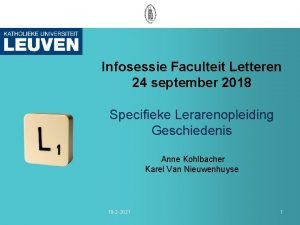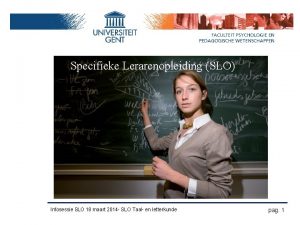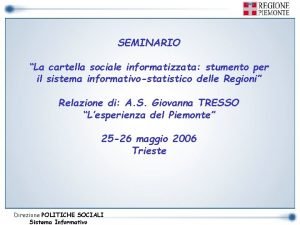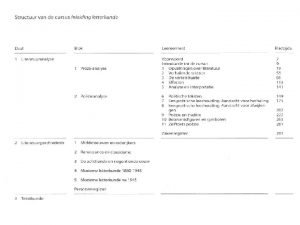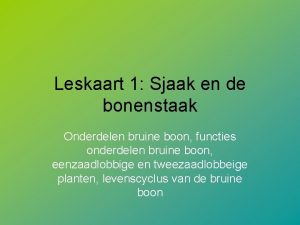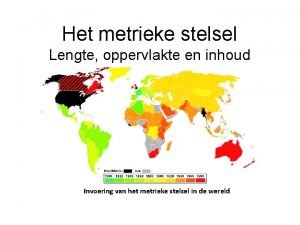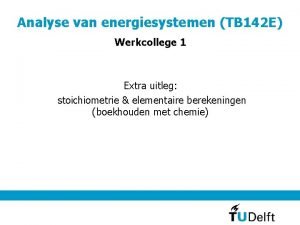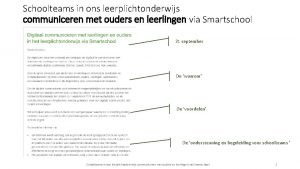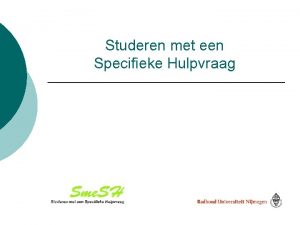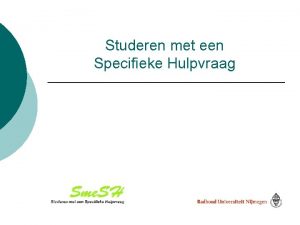Sociale ongelijkheid in het leerplichtonderwijs met specifieke aandacht
























- Slides: 24

Sociale ongelijkheid in het leerplichtonderwijs, met specifieke aandacht voor het secundair onderwijs Studiedag VFO/SSL - 22 november 2007. Jan Van Damme, K. U. Leuven

INLEIDING 1. Wat leerden we uit het LOSO-project? 2. Wat moeten we denken van het PISAverhaal? 3. Conclusie

1. Wat leerden we uit het LOSO-project? a. Eindpositie S. O. (en vertraging) : functie van sekse, SES en allochtoon/autochtoon? - zonder aanvangskenmerken S. O. - met aanvangskenmerken S. O. b. Effect van soort medeleerlingen als vorm van kansenongelijkheid + mogelijke reacties van scholen en leerkrachten

Eindpositie S. O.

Laatste succesvolle positie ih. S. O. zonder controle voor aanvangskenmerken - Meisjes > Jongens -Hoge SES > Lage SES -Autochtonen > Allochtonen Interactie-effect tussen etniciteit en SES: het effect van SES is kleiner voor allochtone leerlingen dan voor autochtone leerlingen

Laatste succesvolle positie ih. S. O. onder controle voor aanvangskenmerken - Meisjes > Jongens -Hoge SES > Lage SES - Geen effect van etniciteit

Model zonder controle voor aanvangskenmerken van leerlingen: ‘Totale Effecten’

Model onder controle van aanvangskenmerken van leerlingen: ‘Netto Effecten’

1. Wat leerden we uit het LOSO-project? a. Eindpositie S. O. (en vertraging) : functie van sekse, SES en allochtoon/autochtoon? - zonder aanvangskenmerken S. O. - met aanvangskenmerken S. O. b. Effect van soort medeleerlingen als vorm van kansenongelijkheid + mogelijke reacties van scholen en leerkrachten





1. Wat leerden we uit het LOSO-project? 2. Wat moeten we denken van het PISAverhaal? 3. Conclusie

2. Wat moeten we denken van het PISA-verhaal? a. De OESO en anderen brengen het met verve. b. Wordt dat verhaal bevestigd door ander onderzoek? • bijdrage UCL • bijdrage van de Hofmans e. a. • bijdrage van Dronkers e. a. • eerste resultaten van PIRLS 2006 in Vlaanderen c. Andere vragen die rijzen

Hofman et al. : some conclusions • countries that include high percentages of students within grant-aided education have been performing better in terms of quality than countries that are dominated by public schools (or less than 10%) • Furthermore, the native students in these countries tended to be near the top of the quality rankings • Countries with relatively high percentages of students in grant-aided schools tended to perform better than others when equity dimensions are taken into account. The gap in performance between low/ses and native high/middle-ses students is frequently smaller • The Netherlands and Belgium scored well overall and in terms of performance of their low/ses minorities. • However, for their ethnic minority students, the picture was by no means as favourable. • A reverse pattern can be seen for countries as Portugal and Spain

Immigrants and school segregation by Dronkers & Levels (PISA 2003)

Study 1 by Levels and Dronkers (2005) Big differences in achievement between students from another ethnic background and native students Why? 1) Country of origin 2) Country of residence 3) SES

• Data: PISA 2003 (students math achievement at age 15) • Results: 1) Country of origin → achievement of students 2) Country of residence → achievement of students 3) Effects of country of origin on achievement are stronger than the effects of country of residence 4) 1 st and 2 nd generation students from countries in West-Asia, North-Africa, Latin-America scored lower in math than students from countries in Europe and the Pacific Rim even after controlling for SES → effect of country of origin on achievement cannot be reduced to the effect of SES on achievement →explanation? Distance between culture of origin and current culture

Study 2 by Dronkers and Levels (2005) Main research question: Are the lower achievement of students from another ethnic background related to the SES and the ethnic school composition? Hypotheses: 1) The effect of the SES and the ethnic composition of schools on achievement is larger for the students from another ethnic background than for native students 2) The variation between countries of the effect of SES and the ethnic composition of schools on achievement is related to differences in school resources 3) The effect of the SES and the ethnic composition of schools on achievement is larger for students from West-Asia, North-Africa and Latin America than for students from other regions

Main results: 1) The SES composition of schools has a larger impact on achievement than the ethnic composition of schools 2) The SES and the ethnic composition of schools have independent effects on achievement 3) The effects of the ethnic school composition are not larger for students from West-Asia, North-Africa, Latin-America than for students from Europe and the Pacific Rim → the differences in achievement between students from different ethnic background could not be explained by the school SES en ethnic seggregation

4) The variation between countries of the effect of SES and the ethnic composition of schools on achievement was not related to differences in school resources 5) The high achieving students in math (native students and students from Europe, North-America, Australia and Southeast Asia) are more negatively influenced by the ethnic school segregation than the lower achieving students in math → the ethnic school segregation is not negative for all students 6) The SES segregation of schools is negative for all students

2. Wat moeten we denken van het PISA-verhaal? a. De OESO en anderen brengen het met verve. b. Wordt dat verhaal bevestigd door ander onderzoek? c. Andere vragen die rijzen: • Verwachte evoluties gezien het gevoerde beleid • Is een benadering op basis van een leeftijdscohorte adequaat om het onderwijs te evalueren? • Zijn de prestatieverschillen tussen scholen meer dan instroomverschillen? • Wat meet PISA?

Conclusie: Aan welk soort onderzoek is er behoefte?
 Anne kohlbacher
Anne kohlbacher Specifieke lerarenopleiding gent
Specifieke lerarenopleiding gent Mandati assistente sociale
Mandati assistente sociale Cartella sociale informatizzata
Cartella sociale informatizzata Bedankt voor jullie aandacht
Bedankt voor jullie aandacht Aandacht voor rekenen groep 3
Aandacht voor rekenen groep 3 Www.kahoot
Www.kahoot Aandacht voor ontwikkelingsgericht werken
Aandacht voor ontwikkelingsgericht werken Aandacht voor ontwikkelingsgericht werken
Aandacht voor ontwikkelingsgericht werken Bedankt voor jullie aandacht
Bedankt voor jullie aandacht Aandacht voor ontwikkelingsgericht werken
Aandacht voor ontwikkelingsgericht werken Feodaal stelsel
Feodaal stelsel Stamboom aartsvaders
Stamboom aartsvaders Uit het oog uit het hart
Uit het oog uit het hart Het bloed stroomt waar het niet gaan kan
Het bloed stroomt waar het niet gaan kan Het regent en het is november
Het regent en het is november Zijn het heupbeen en het dijbeen van de walvis rudimenten?
Zijn het heupbeen en het dijbeen van de walvis rudimenten? Zwiens
Zwiens Spierschede
Spierschede Kan het dametje met de centimeter meten kg
Kan het dametje met de centimeter meten kg Tekst ik wandel in het licht met jezus
Tekst ik wandel in het licht met jezus Hartvormig bultje bruine boon functie
Hartvormig bultje bruine boon functie Oppervlakte metriek stelsel
Oppervlakte metriek stelsel Atoomnr 33
Atoomnr 33 God vaart voor het oog met gejuich omhoog
God vaart voor het oog met gejuich omhoog
